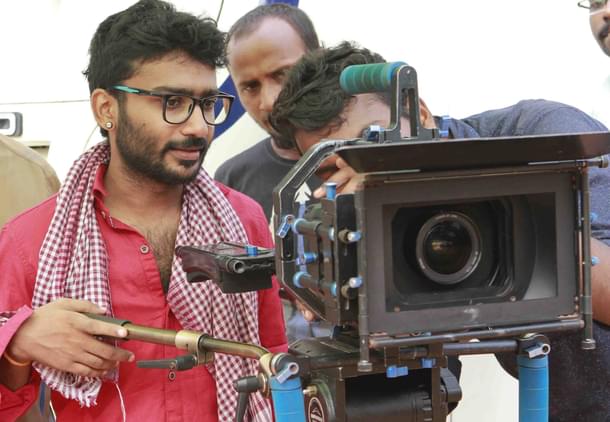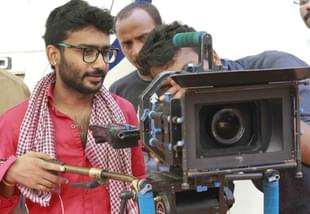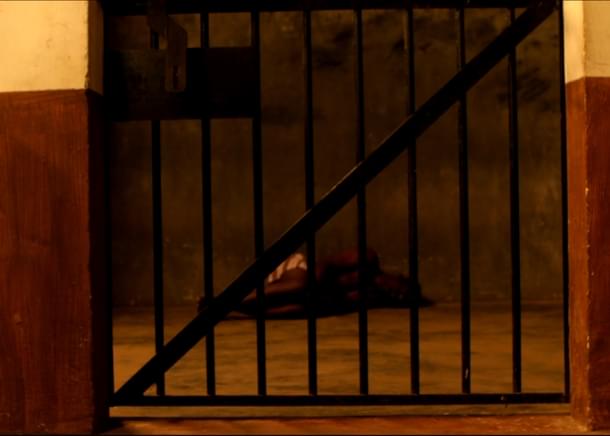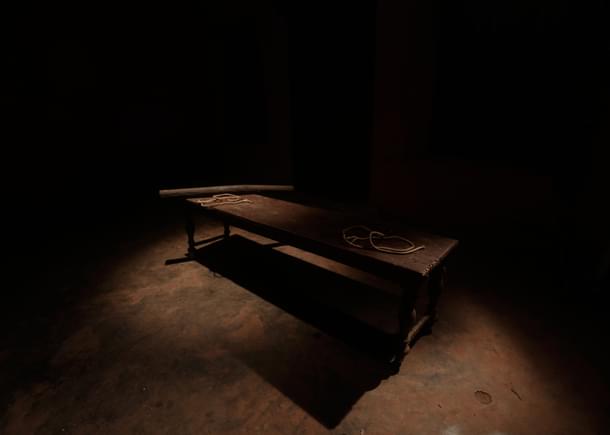Politics
Kerala CBFC Refuses To Certify His Documentary On Emergency; What Will This Director Do Now?
M R Subramani
Jan 04, 2018, 12:43 PM | Updated 12:42 PM IST
Save & read from anywhere!
Bookmark stories for easy access on any device or the Swarajya app.


Yadu Vijayakrishnan, the maker of the documentary 21 Months of Hell, isn’t the one who will retire to a quiet corner or throw his hands up in despair because his documentary on the Emergency was denied a certification for public viewing. As he fights the regional ‘censor board’ of Kerala, he is busy checking his camera and other equipment for his future projects. A man, who is interested in history and anthropology, Yadu Vijayakrishnan is fascinated by the way society and civilisation behave differently through the ages. From directing a television series, he has moved on to making a film on environment and now a documentary on the Emergency that he wants to convert into a full-length movie. In between his busy schedule, Yadu Vijayakrishnan managed to answer Swarajya’s questions on the controversy surrounding the certification of 21 Months of Hell:
You seem to be a man in love with nature, making a film like Nelumbo (2016). What then inspired you to make a documentary on the Emergency, 21 Months of Hell?
Although Nelumbo was completed and screened at the Kolkata International Wildlife and Environment Film Festival in 2016, I started shooting the film in 2013 when I was doing my final year of my BA Multimedia degree. It was a crowd-funded movie and due to budget constraints, it took me over two years to finish it. Nelumbo is a larger version of a five-minute short film, The Touch of Nature, I directed in 2012. Nelumbo can be considered an environmental film but it features a lifestyle of a neanderthal man. I have interests in history and anthropology. It has always fascinated me, the way society and civilisations behave differently through the ages.
After finishing my graduation, I joined a Malayalam television channel called Janam TV (while I was pursuing Masters in social work through distance education), where the executives tasked me to direct two programmes. One was a travelogue, which revisits Adi Sankara's footsteps and the other a weekly historic documentary programme. There I made documentaries on historic subjects such as the Malabar riots, the Travancore-Dutch War, the Communist betrayal during Independence struggle and some other international incidents as well.
25 June 2015 was the 40th anniversary of the declaration of the Emergency. My chief, Rajesh Pillai, assigned me to make a four-episode documentary series on the subject. I was thrilled to make it. Usually, most of the people born and raised in Kerala hold the idea that Emergency was a required state of law. Nonetheless, for me, I have some of my family members who participated in anti-Emergency struggle. My grandfather's younger brother, K Raman Pillai, was a Jan Sangh (later BJP) leader at that time. He was the general secretary of Kerala wing of Lok Sangharsh Samiti formed by the late Jayaprakash Narayan to counter the Emergency. So, I had an idea how unfortunate Emergency was. By making this TV series, I got the chance to meet some of the surviving victims of Emergency and found out that how little recognition they have got in public. I was determined to make a movie on the subject so that there will be a general awareness about the Emergency.
I left my job at Janam TV in September 2016 for a career in films, beginning as a cinematographer. However, finding investors to make such a movie proved to be more difficult than I thought. Most of the producers I met were quite reluctant as they saw me as young and inexperienced. I needed to prove that I could handle the subject and showcase it on the screen. That's how I came up with the idea of making a documentary on the subject on a meagre budget and using it as a platform to make a full length movie. I was able to connect with Mr J Nandakumar, a senior leader of Rashtriya Swayamsewal Sangh (RSS), through my friend Vayujith, an RSS activist. I pitched the idea to Nandakumarji and he helped me find investors for the documentary production. As you know, RSS and Jan Sangh were at the forefront in anti-Emergency activities. With the cooperation of members of a Facebook group called “Kerala Haindava Darsanam”, a film production company with the name “Arise Media Network” was formed by the investors in order to fund the documentary.
Is the Rajan case a reason for you to make this documentary? Has that case had any impact on you or is there at least any remote connection to that?
Rajan case is a very popular and unfortunate incident. Whenever we talk about Emergency, the first thing everyone recalls is the Rajan case. The events have been made into a National Award winning film Piravi as well. In Kerala, people talk about Naxalites whenever the topic of Emergency is raised. Naxalism or Rajan incident has nothing to do with my documentary. The cops mistook Rajan as a Naxal and tortured him to death. It showed how the cops at that time needed little evidence to torture someone. Everybody is aware of this story. However, there are thousands of other stories that have not been heard. Naxals were terrorists who fought against the Republic of India and its Constitution. They wanted to establish an extreme left government in India. Naxals started their agitation some six years before Emergency. Their activities during Emergency can't be called anti-Emergency, they're anti-India. The Jan Sangh, RSS and socialists were the ones who fought against Emergency and, that too, in a peaceful, Gandhian way. The whole intention of the documentary was to acknowledge their invaluable services.

What actually went into the making of 21 Months of Hell ? Can you recall your experience in making the documentary?
Most people think of me as a militant and reckless person being a director of a brutal violence documentary. But I'm kind of a guy who faints seeing his own blood. I became a vegetarian at the age of 13 just because I can't stand the idea of killing animals.
On my first meeting with an Emergency victim (in 2015 during the TV series shoot), Sri Vaikom Gopakumar, I remember my cameraman setting up the camera and the crew were behind me. Gopan chettan (as I call him) started telling me about the torture he went through. He narrated it in such a way that I recreated the scene in my mind. The next thing I knew was my crew spraying water on me and somebody holding me from falling down. So, coming back to shoot the same subject in 2017, I told my crew members to watch out carefully so that I won’t get myself injured. I consider the documentary as an honour for me to meet and interview all the brave souls who were ready to sacrifice their lives to restore democracy in India. Shooting the re-enactment scenes lasted just four days. It was kind of a stress to manage all the art works, costumes and other production materials of the 1970s in such a low budget. Somehow, I was able to pack it all up under budget.
Were there any problems initially in making the documentary? If you would want to point out one unforgettable moment in making this documentary, what will it be?
There were problems throughout, but all were technical – usual things like some actors not showing up, missing art materials, studio unavailability and so on. I will point out one particular incident. There is a scene in which a cop forces a detainee to wash a dirty latrine using his bare hands. For this, I asked my art director to make a dummy dirty latrine so that the actor could perform the scene without contaminating his hand. But my art director told me that making such a property will cost so much that it wouldn’t be within my budget. So, I decided to shoot the scene without showing the actor's hand washing a dirty old used latrine that was at our shooting location.
At the time of shoot, Roy, the actor, hearing my instructions, told me that he will wash the real latrine in front of the camera. I told him it wasn’t necessary. He told me his part time job is cleaning septic tanks and he wasn’t bothered about it. Thus, the actor actually cleaned a real used dirty latrine in front of the camera.
Most of my actors had other professions; but they had passion for acting as well. If I would have paid a professional celebrity for the role, it's obvious that he wouldn't have done this. I was extra cautious during the shoot to prevent any causalities. As this was a low budget work, we didn't have professional stunt team to set up safety measures. I told the actors who played the role of cops to be careful while acting out the scenes of torture. Unfortunately, during the shoot of the torture method 'doglock', one of the actors who played the role of a victim injured his back and had to undergo medical treatment afterwards.
You have interviewed some of the victims of Emergency. What has been their experience during the Emergency? Was their normal life affected? How? How were their families affected?
It's same as the title of the documentary, it was literally a hell for all these victims during Emergency. RSS and Jan Sangh had a functionary at that time to organise the schedule of non-violent protests, print underground uncensored publications and so on. Some of them had to be in hiding organising the whole protests. They couldn't be with their family and had to change locations in disguise. Others who were assigned to protest spent months in jail undergoing brutal tortures. Women who participated in the protests were arrested as well. After their release, some of their marriage proposals were cancelled. It was more of a dystopia for all those who wanted to restore democracy.
The documentary also deals with torture. What exactly did the people you interviewed go through? What were the methods of torture used?
Vaikom Gopakumar suffered kidney problems consequent to the “rolling” torture method. This lead to swelling on one of his legs. He had to surgically remove a testicle due to the impact of brutal torture. Krishnakumar, known as Aniyankunj at the time, had his eardrum crushed after a cop inserted tip of a feather into his ear. He lost all his teeth from thrashing. He can't use prosthetic teeth because of jaw displacement. An injury to the spine rendered Shambu Namboodiri immobile. Frequent beating by the police made M I Sukumaran lose sight in one of his eyes. There are victims who suffered vertigo, who can't sleep on mattresses and who have blocks in esophagus or windpipe.
There are hundreds of other victims who I haven’t interviewed. Some of them died recently. There are still unheard stories on the Emergency.
Did the victims of Emergency say if there were any instructions from the higher-ups like the then Home Minister K Karunakaran or then prime minister Indira Gandhi or anyone else?
By curbing civil liberties, prime minister Indira Gandhi encouraged the suppression of anti-government voices. The police were given full freedom to arrest and detain anyone under MISA (Maintenance of Internal Security Act). They didn't need any proof for arresting and torturing a person. Kerala was ruled by an alliance of Communist Party of India (CPI) and Congress at that time. C Achyutha Menon was the chief minister and Karunakaran the home minister. Together they created total misery for their opponents. Some representatives of the Lok Sangharsh Samiti met Karunakaran at that time, requesting him to stop the torture in jails. However, the home minister refused. Congress members utilised the opportunity to seek revenge against their personal rivals. A lead from a Congress activist was enough for the police to arrest and torture someone.
What did the Kerala censor board tell you when it rejected certification? One of the censor board members has been quoted as saying that this is “docu-fiction”: Your comments.
The regional office of the Central Board of Film Certification (CBFC) claimed that there are several violations that lead to the denial of certificate. The most ridiculous claim they made was that there is no evidence for torture methods during Emergency. I told them we have testimonies of surviving victims and case reports of that time. They replied that they need "official government reports". Even the press was suppressed during Emergency. Will a government prepare a report on the crime it committed? Arguing that they have denied certificate to my work because it's “docu-fiction” is baseless as well. Yes, there are recreated scenes of torture. It's because we have no footage of such historical incidents. It is very common in documentaries. If you check out all those international documentaries, you can see they re-visualise historical events. Moreover, there is no category called “docu-fiction” in the censor board. There are feature films, documentaries, short films and advertisements.
If they had a “docu-fiction”category then I would’ve surely applied for it. The same CBFC till now has certified many documentaries which had fictional scenes. When I asked the officer about this hypocrisy, she asked me to not compare my work with any other.
CBFC also said it contains too much violence and is political. How can we make a documentary on torture methods without violence? That is why I applied for an 'A' certificate. I don't want anyone below 18 years of age to watch this as it has mature content. Everyone knows how cops behave. During the time of Emergency, they frequently used abusive language that would make one's ear bleed. Yet, I chose not to include any abusive words in the documentary. Still, CBFC says it has bad language.

Are the allegations on Mahatma Gandhi being insulted or the national flag being desecrated true?
I'm glad that you asked this question because all the misconceptions have to be clarified. People branded me anti-Gandhian and that Mahatma Gandhi was criticised in the documentary. This is far from the truth. 21 Months of Hell deals with the hardships of those who protested against Emergency in a Gandhian manner. There is a scene in the film which is based on real life incident where the protesters chant the slogan Bolo Bharat Mata ki Jai, Bolo Gandhiji ki Jai. A police officer who enters the scene to disperse the protesters shouts "hail the living Gandhi instead of the dead one". Subsequently, when the cops beat up the peaceful protesters, the national flag which they were waving falls down on to the ground. This is what the censor board took as insult to Mahatma Gandhi and the National Flag.
By the same logic, Mahabharat might be considered misogynist as there is a scene where the Kauravas undrape Draupadi’s sari. Mahabharat isn’t misogynist because the negative characters committed wrong acts and the epic discusses the cruelty of the act as well.
There isn't a single anti-smoking advertisement without showing the image of smoking. They need to show smoking to portray the side-effects caused by it. It's a form of utilitarianism in media. The problem with utilitarianism is that just like sarcasm or satire, one needs to have cognitive depth to understand it. It is very unfortunate that the officials of the censor board were unable to grasp the good intention.
Do you suspect a hidden hand in the rejection by the Kerala censor board?
Maybe the censor board officer of Kerala is worried because of the issues the film Indu Sarkar faced a few months ago. She told me she doesn't want to take the risk of approving this film and that she preferred it be certified by higher authorities. One member of the censor committee who watched the film is a known public figure in Kerala. She has strong affiliation to the CPI, which was ruling Kerala during Emergency. Along with the Congress, the CPI was also responsible for human rights violation at that time. Maybe it's because of this reason they wanted to suppress the film.
The CPI supported Emergency but the CPI-M opposed it. What would have forced the censor board to reject certification?
CBFC Kerala is a central government body. Nevertheless, most of the members are leftists or are affiliated to Congress. BJP rules at the Centre and doesn't have much influence. Although CPI-M boasts about its anti-Emergency struggle, the truth is that after initial arrests, all the leaders were released under a secret understanding that the party won’t take part in any agitations anymore. When the leaders of Lok Sangharsha Samiti approached CPI-M leaders such as E M S Namboodiripad for support, they refused to cooperate. Consequently, most of the prisoners in Kerala at that time were from the RSS or Jan Sangh. If Kerala recognises the efforts of Emergency victims and decides to give them medical benefits, then it will aid RSS and current BJP members of Kerala. Obviously, CPI-M which rules Kerala at the moment doesn’t want that. It considers RSS its primary opponent.
Has the documentary been shown in any film festivals abroad? What has been the response?
21 Months of Hell is still waiting to be premiered. We had a private screening in New Delhi, where the Union Minister of State, Ashwini Kumar Choubey, and the BJP Delhi president, Manoj Tiwari, watched the film. Mr Choubey addressed the audience after the screening and talked about his experience as a victim of torture during Emergency. The audience had an overall positive opinion. Apart from this screening, no other public exhibition has been made yet.
How has the media support been to the refusal of certification? Has any political party taken up this issue?
I really want to thank all the national media. I never thought they would take up the issue with such interest. Almost all national English news channels interviewed me live. The unfortunate thing is that the media in Kerala, where I belong to, was least interested. Only two Malayalam news channels took up the issue. The most popular news channel of Kerala took my interview a day before the national media took up the issue. However, this channel hid the news altogether. It is pretty ironic that while I'm a resident of Thiruvananthapuram where the headquarters of all Malayalam news channels exist, they ignored the issue while media of Mumbai, Delhi and Bengaluru were active in broadcasting the news.
Attempts have been made to reach out to the BJP to address this issue. However, no public comments have been made by them yet.
Do you plan to take up this matter with anyone outside Kerala?
As soon as I get the copy of the show cause notice from Kerala CBFC, I will request for a revising committee from headquarters of CBFC in Mumbai to review the film. I'm ready to modify and edit the film if their claims of violation are convincing. I'm hopeful that this revising committee will approve the film, or else, I have no other option but to approach the court.
M.R. Subramani is Executive Editor, Swarajya. He tweets @mrsubramani





